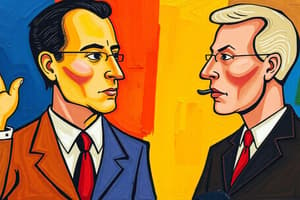Podcast
Questions and Answers
Match the leadership styles with their corresponding characteristics:
Match the leadership styles with their corresponding characteristics:
Autocratic = Decision-making without consulting subordinates. Democratic = Involving team members in decision-making. Laissez-faire = Providing minimal guidance and direction. Transformational = Inspiring followers to reach their potential.
Match the following leadership styles with their primary focus:
Match the following leadership styles with their primary focus:
Transactional = Exchanging rewards and punishments for motivation. Servant = Prioritizing the needs of subordinates. Charismatic = Using personal charm to inspire followers. Bureaucratic = Adhering strictly to rules and procedures.
Match the leadership styles with the situations where they are most effective:
Match the leadership styles with the situations where they are most effective:
Situational = Adapting leadership based on followers' needs. Cognitive = Focusing on problem-solving and decision-making. Autocratic = Effective in situations requiring quick decisions. Democratic = Suited for enhancing team creativity and morale.
Match the limitations associated with each leadership style:
Match the limitations associated with each leadership style:
Pair the leadership styles with their impact on team dynamics:
Pair the leadership styles with their impact on team dynamics:
Match the leadership styles with their corresponding benefits:
Match the leadership styles with their corresponding benefits:
Match the elements that define specific leadership styles:
Match the elements that define specific leadership styles:
Match each leadership style with its primary characteristic related to decision-making:
Match each leadership style with its primary characteristic related to decision-making:
Match leadership styles based on their focus on motivation and engagement:
Match leadership styles based on their focus on motivation and engagement:
Match the following leadership styles with their most suitable organizational cultures:
Match the following leadership styles with their most suitable organizational cultures:
Match the leadership style with the corresponding employee development approach:
Match the leadership style with the corresponding employee development approach:
Match leadership styles to their application in managing team conflicts:
Match leadership styles to their application in managing team conflicts:
Match the appropriate reactions from each leadership style when encountering resistance:
Match the appropriate reactions from each leadership style when encountering resistance:
Classify leadership styles based on their responses to organizational change:
Classify leadership styles based on their responses to organizational change:
Associate leadership behaviors with specific leadership styles:
Associate leadership behaviors with specific leadership styles:
Match impacts on team creativity and innovation to leadership styles:
Match impacts on team creativity and innovation to leadership styles:
Pair roles of leaders with specific leadership styles:
Pair roles of leaders with specific leadership styles:
Match leadership styles and behaviors with the effects on motivation and engagement in workers:
Match leadership styles and behaviors with the effects on motivation and engagement in workers:
Pair the impacts of styles on team building and cohesiveness to leadership styles:
Pair the impacts of styles on team building and cohesiveness to leadership styles:
Match impacts on risk management to leadership styles:
Match impacts on risk management to leadership styles:
Flashcards
Autocratic Leadership
Autocratic Leadership
Leaders make decisions without consulting subordinates, exerting a high degree of control.
Democratic Leadership
Democratic Leadership
Leaders involve team members in decision-making, valuing opinions and seeking consensus.
Laissez-faire Leadership
Laissez-faire Leadership
Leaders provide minimal guidance, delegating authority and allowing team members to make decisions.
Transformational Leadership
Transformational Leadership
Signup and view all the flashcards
Transactional Leadership
Transactional Leadership
Signup and view all the flashcards
Servant Leadership
Servant Leadership
Signup and view all the flashcards
Charismatic Leadership
Charismatic Leadership
Signup and view all the flashcards
Bureaucratic Leadership
Bureaucratic Leadership
Signup and view all the flashcards
Situational Leadership
Situational Leadership
Signup and view all the flashcards
Cognitive Leadership
Cognitive Leadership
Signup and view all the flashcards
Study Notes
- Existen varios tipos de estilos de liderazgo, cada uno con sus propias características y enfoques.
- La comprensión de estos estilos puede ayudar a los líderes a ser más eficaces, adaptables y a inspirar a sus equipos.
Liderazgo Autocrático
- Los líderes autocráticos toman decisiones sin consultar a sus subordinados.
- Ejercen un alto grado de control y esperan que se sigan sus instrucciones al pie de la letra.
- Este estilo puede ser eficaz en situaciones que requieren decisiones rápidas y en las que existe una clara cadena de mando.
- Puede generar desmotivación y resentimiento si se utiliza en exceso.
Liderazgo Democrático
- Los líderes democráticos involucran a los miembros del equipo en el proceso de toma de decisiones.
- Fomentan la participación, valoran las opiniones de los demás y buscan el consenso.
- Este estilo puede mejorar la moral, aumentar la creatividad y fomentar un sentido de propiedad entre los miembros del equipo.
- Puede llevar mucho tiempo y ser ineficaz en situaciones de crisis.
Liderazgo Laissez-faire
- Los líderes laissez-faire proporcionan muy poca orientación o dirección a sus subordinados.
- Delegan la mayor parte de la autoridad y permiten que los miembros del equipo tomen sus propias decisiones.
- Este estilo puede ser eficaz con equipos altamente cualificados y motivados que requieren poca supervisión.
- Puede conducir a la confusión, la falta de responsabilidad y el bajo rendimiento si no se gestiona adecuadamente.
Liderazgo Transformacional
- Los líderes transformacionales inspiran y motivan a sus seguidores a alcanzar su máximo potencial.
- Articulan una visión convincente del futuro, desafían el status quo y proporcionan apoyo y entrenamiento individualizado.
- Este estilo puede conducir a altos niveles de compromiso, innovación y rendimiento.
- Requiere fuertes habilidades de comunicación, carisma e inteligencia emocional.
Liderazgo Transaccional
- Los líderes transaccionales se centran en el intercambio de recompensas y castigos para motivar a sus subordinados.
- Establecen objetivos claros, supervisan el rendimiento y proporcionan retroalimentación.
- Este estilo puede ser eficaz en situaciones que requieren eficiencia, previsibilidad y cumplimiento de las normas.
- Puede sofocar la creatividad, limitar la autonomía y no inspirar a los seguidores a ir más allá de las expectativas.
Liderazgo de Servicio
- Los líderes de servicio priorizan las necesidades de sus subordinados y se esfuerzan por servirles.
- Fomentan el crecimiento, el desarrollo y el bienestar de los miembros del equipo.
- Este estilo puede generar confianza, lealtad y un fuerte sentido de comunidad.
- Requiere humildad, empatía y un compromiso genuino con el servicio a los demás.
Liderazgo Carismático
- Los líderes carismáticos poseen una personalidad magnética que atrae e inspira a los seguidores.
- Tienen una fuerte visión, excelentes habilidades de comunicación y la capacidad de generar entusiasmo y pasión.
- Este estilo puede ser muy eficaz para movilizar a las personas hacia un objetivo común.
- Puede ser arriesgado si el líder carece de ética o utiliza su carisma para manipular a los demás.
Liderazgo Burocrático
- Los líderes burocráticos se adhieren estrictamente a las reglas, los procedimientos y las jerarquías.
- Hacen hincapié en el orden, la eficiencia y la estandarización.
- Este estilo puede ser eficaz en organizaciones grandes y complejas que requieren un alto grado de control y rendición de cuentas.
- Puede ser rígido, inflexible y sofocar la innovación.
Liderazgo Situacional
- Los líderes situacionales adaptan su estilo de liderazgo en función de la situación y las necesidades de sus seguidores.
- Evalúan el nivel de preparación de los miembros del equipo y proporcionan el nivel adecuado de apoyo y dirección.
- Este estilo requiere flexibilidad, adaptabilidad y buenas habilidades de juicio.
- Puede ser difícil de implementar de forma coherente y puede generar confusión si los miembros del equipo no entienden por qué el líder está cambiando su enfoque.
Liderazgo Cognitivo
- Los líderes cognitivos se centran en los procesos de pensamiento, la resolución de problemas y la toma de decisiones.
- Fomentan el pensamiento crítico, la creatividad y la innovación.
- Este estilo puede ser eficaz en situaciones complejas y ambiguas que requieren soluciones novedosas.
- Requiere fuertes habilidades analíticas, conceptuales y de comunicación.
Studying That Suits You
Use AI to generate personalized quizzes and flashcards to suit your learning preferences.




